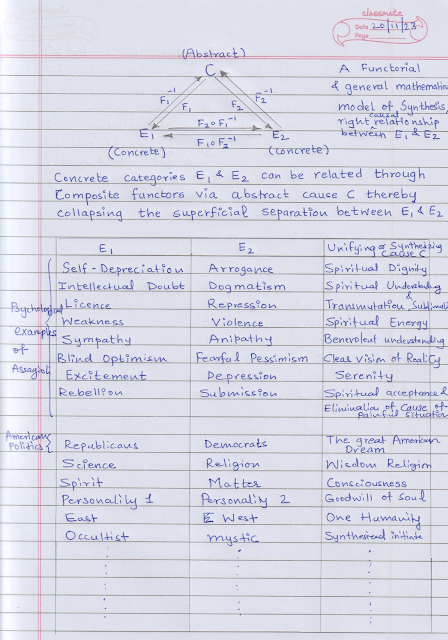A revised mathematical model of synthesis
Let us establish (as it is progressively revealed to my intuition from the ashram of synthesis) much more accurate concrete mathematical model of synthesis (or harmony, brotherhood, unity, fusion etc) as taught and demonstrated by some of the initiates of the last two centuries (messengers of the World-Teacher) as follows:
H.P. Blavatsky : A Synthesis of Philosophy, Religion and Science (The Secret Doctrine, Ageless Wisdom and Theosophy: an esoteric wisdom religion) (A Ray 1 and 2 impulse of synthesis)
Djwal Khul and Alice Bailey : A Synthesis of the Seven Rays (The 24 synthetic Books on Esoteric Philosophy of Seven Rays) (A Ray 2 wisdom impulse of synthesis)
Sri Aurobindo and The Mother : Integral and Synthesis of Yoga, Auroville - Experimental city of Synthesis (A Ray 4 and 6 artistic harmonizing impulse of synthesis)
Nicholas and Helena Roerich and Vicente Beltran Anglada: Agni Yoga (A Ray 1,2,7 impulse fiery and magical impulse of synthesis)
Alexander Grothendieck (with Saunders Maclane): Category Theory (A Ray 3 and 5 Abstract mathematical impulse of synthesis)
along with many others such as Assagioli (psychosynthesis), Masanobu Fukuoka (permaculture and synthetic farming), Cedercrans (teachings on the ashram of synthesis), Francia A. La Due (a more christian approach to Theosophy through Hilarion) Douglas Baker and many more.
Much more remains to be done such as unified field theory (a holy grail in the synthesis of physics, many physicists including Albert Einstein have been trying to derive that model) before Humanity at cross-roads and in crisis can be safely ushered in the new age or perish as forewarned by Djwal Khul and Alice Bailey in the Problems of Humanity.
Starting with a functorial cause and effect model of karma derived in my thesis and discussed in an earlier post, and applying the essential concept of synthesis from teachings of above mentioned teachers, we are naturally led to attached model (see the image attached).
An (unifying or synthetic) abstract cause (C) catgeory is transformed into concrete category effect 1 (E1) (through functor F1) and effect 2 (E2) (through functor F2). At concrete level, the Effects 1 and 2 are viewed in duality as separative and in conflict (given the over-emphasis of current humanity to analytical concrete mind or intellect). Through the abtract (usually at a higher intuitive level) cause, a synthesis begins to appear and is precisely worked out as composite morphism from E1 to E2. Almost all seemingly contradictory effects (often appearing as paradoxes) could be unified or synthesised using this universal mathematics model. Some contemporary examples of conflicts are hinted. Try and work it out for yourself !
Had the greatest mathematician of the last century, Grothendieck (who gave up on the non-ethical mathematical community sensing the competition and stealing of his work for cheap awards and fame and went into solitude in Pyrenes after retirement in 1991) been alive he would have been elated to see psychological and occult significance of his universal mathematics.
It is at times painful to see such separation and conflicts going on everywhere today in a polarized world. But then I remind myself KH's words:
"What else could one expect of men so nearly related to the lower kingdom from which they evolved? True also, our numbers are just now diminishing but this is because, as I have said, we are of the human race, subject to its cyclic impulse and powerless to turn that back upon itself. Can you turn the Gunga or the Brahmaputra, back to its sources; can you even dam it so that its piled up waters will not overflow the banks? No, but you may draw the stream partly into canals and utilize its hydraulic power for the good of mankind. So we, who can not stop the world from going in its destined direction, are yet able to divert some part of its energy into useful channels."
To know, to dare, and to KEEP SILENT has always been a motto of an occultist.




Comments
Post a Comment